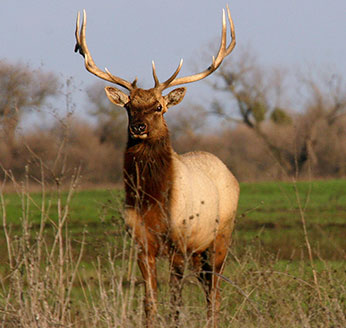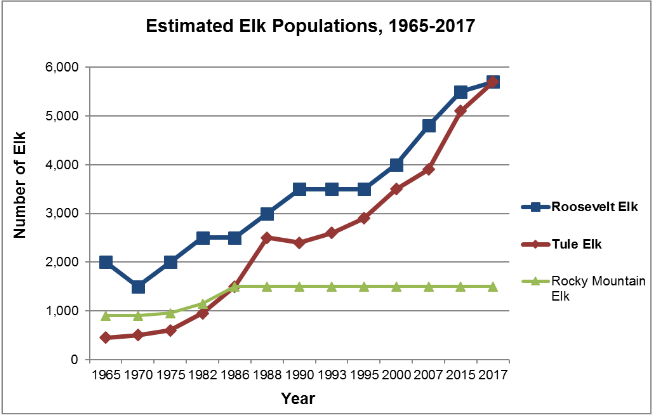Biology
Class: Mammalia | Order: Artiodactyla | Family: Cervidae | Genus: Cervus
Three subspecies of elk occur in California: Roosevelt (Cervus canadensis roosevelti), Rocky Mountain (C. c. nelsoni), and tule (C. c. nannodes) elk.

Management
California's elk herds are a valuable resource to outdoor enthusiasts of all types. In order to ensure the long term sustainability of elk populations, CDFW has established conservation and management objectives to maintain healthy herds, reestablish elk in suitable historic range, provide public educational and recreational opportunities to enjoy elk, and to alleviate conflicts involving elk on private property.
CDFW's Elk Management Program (Program) is made up of branch and field biologists who work together coordinating projects across the range. The Program, its activities, and staff are supported almost entirely by hunters through the purchase of California hunting licenses and elk tags. Additional support for elk conservation comes from federal funds derived from the Federal Aid in Wildlife Restoration Act (also known as the Pittman-Robertson Act or "P-R"; for additional information on P-R, visit The Wildlife Society Policy Brief P-R (PDF)).
Ongoing projects within the Program include population assessment studies, movement or migration studies, monitoring and research projects to improve our understanding of population dynamics, responding to public inquiries related to elk, and providing guidance and expertise to other agencies, universities, non-governmental organizations, and private entities interested in the conservation and management of elk.
One example of the Program success is that CDFW has safely and successfully captured and relocated more than 1,200 elk since 1975 using a variety of capture techniques, including chemical immobilization of individual elk, hazing groups of elk into winged corral traps, baiting elk in small corral traps, and chemical/physical restraint of animals using a helicopter and dart- or net-gun operation.
The efficacy of a particular capture technique is determined by various factors such as safety, cost, desired age/sex structure of the capture group, and purpose of the capture (e.g., translocation, biological testing, or marking). The statewide tule elk population has increased from three herds totaling 500 elk in 1970, to 22 herds with approximately 5,700 elk today. This is a tremendous accomplishment and no small feat in a state that is now approaching 40 million people. It demonstrates and highlights the long standing and strong conservation and management practices by CDFW. The ability to build upon those early reintroduction concepts, establishing innovative capture techniques, and continued implementation of management actions that have resulted in and created opportunities for natural range expansion of tule elk continues to be a tremendous success.
 Estimated elk population numbers in California, 1965-2017.
Estimated elk population numbers in California, 1965-2017.
Research and Survey Data
Planning Documents
Elk Management on Private Lands